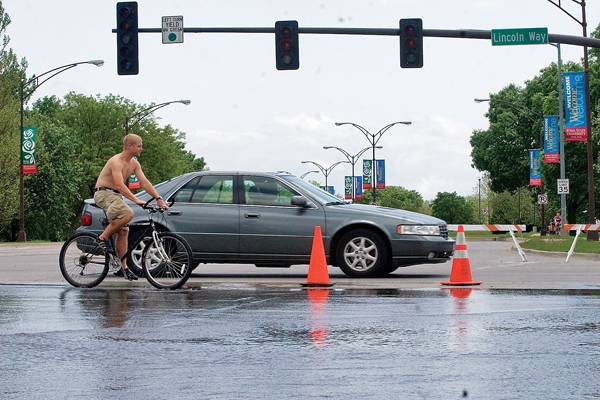Ames recovers from floods of 2008

Water reaches the westbound lane of Lincoln Way at the intersection of Lincoln Way and University Ave, Friday, May 29, 2008. File photo: Iowa State Daily
June 8, 2009
One year ago, the state of Iowa was battered by floods rivaling the intensity of the 1993 Mississippi River floods, and that would go on to be considered the fourth worst natural disaster in U.S. history. For residents of Ames, the devastating event really held no lasting effects for the city.
“There really were no major damages done to this community,” said Bob Kindred, assistant city manager. “Most of it was just cleaning up dirt and mud.”
Duane Pitcher, finance director for Ames, estimated the total recovery cost for Ames at about $250,000, which is little compared to towns that were highly impacted, such as Cedar Rapids.
“Right now our overall recovery cost is sitting somewhere around $3 billion,” said Jim Prosser, city manager of Cedar Rapids. “All of our command and control facilities were flooded. This wasn’t just a few basements with water in them.”
The most significant damage done to Ames was the destruction of a footbridge in Brookside Park that was scheduled to be rebuilt.
While the damage was slight, some precautions were still taken during the upswell of water. The Riverside Manor assisted living community had to be temporarily relocated due to its proximity to Squaw Creek.
“We gathered up some buses, and we took them to the towers for two days,” said Sheila Lundt, assistant city manager in Ames.
Prosser said one of the things that was most helpful in their recovery efforts was learning from the experiences of other communities.
“During the floods, we got a call from Cedar Rapids asking us for some of our emergency response techniques,” Pitcher said. “I asked what they had so far, and the person simply said, ‘Lots of paper and a pen.’”
Prosser estimated that the recovery work for Cedar Rapids was about 20 percent complete and said the real challenge was a financial one.
“We are responsible for most of that $3 billion cost, and cities are very limited in their ability to raise money,” he said. “We could probably raise a few hundred million dollars, but that will be a small drop in the bucket.”
One of the reasons for the disparate levels of damages, besides the location of the storms last year, was the difference in watersheds between the cities.
“Ames’ watershed has a very quick recovery,” Lundt said. “We get a lot of water really fast, but it goes away almost as quickly.”
Prosser said addressing Cedar Rapids’ watershed is paramount.
“If we don’t, we will have another record flood event,” he said. “We’ve begun to address it, but the entire process could take as much as 25 years.”






